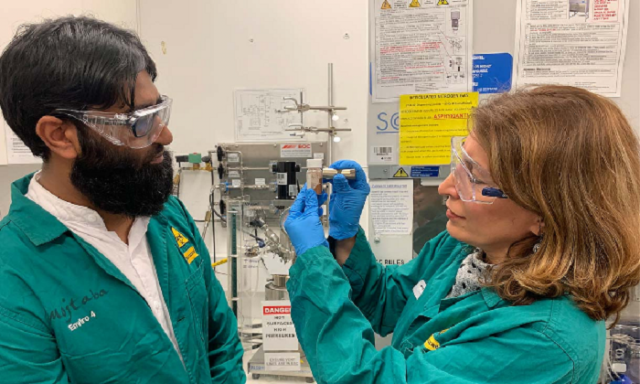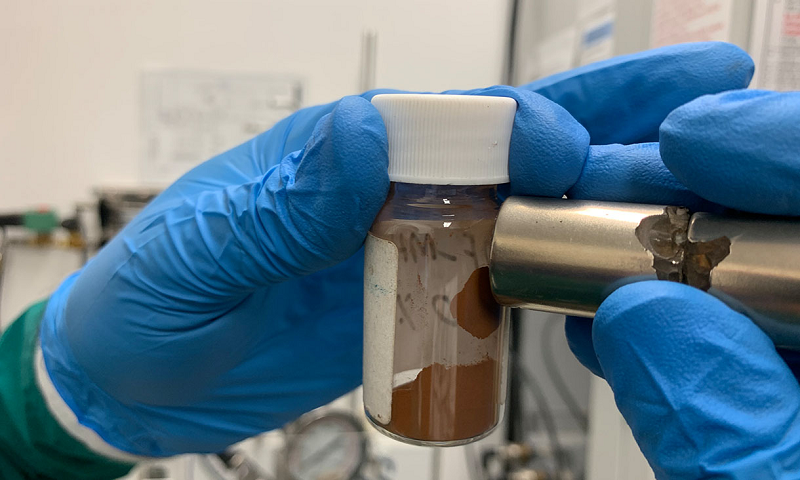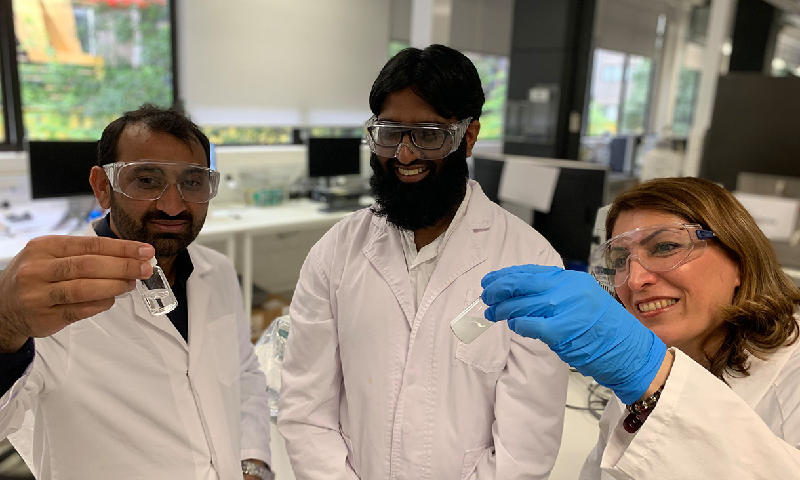Pakistani, Australian scientists develop ‘magnetic powder’ to remove microplastics from water
Existing methods could take days while our invention achieves better results in just one hour, says lead researcher

A team of researchers from Pakistan and Australia has developed adsorbents in the form of powder, capable of removing microplastics and other contaminants from wastewater at a lightning speed.
The material, which looks like ordinary powder, is actually made up of microscopic and ferromagnetic “nanopillard structures”. The carefully-designed particles are composed of two sheets (two-dimensional) of metal-organic framework (MOF), with an array of carbon-encapsulated iron oxide nanopillars sandwiched in a gap between them.
 A magnet attracts the material that the team used to make adsorbents that remove microplastics and dissolved pollutants from water. PHOTO: RMIT University
A magnet attracts the material that the team used to make adsorbents that remove microplastics and dissolved pollutants from water. PHOTO: RMIT University
The design results in a large amount of surface area of 749.7 m2/g, having countless traps which clings even the smallest particles in water.
“Existing methods could take days to remove microplastics from water, while our cheap and sustainable invention achieves better results in just one hour,” said the lead researcher, Professor Nicky Esthtiaghi in a statement published by Australia’s RMIT University.
It can also mops up microplastics 1,000 times smaller than those currently detectable by most advanced treatment plants ever existed. By contrast, conventional purification techniques take days to complete, and even only capture plastic particles of few millimeters but tinier microplastics were unable to be captured before this invention.
The designer and co-lead researcher Dr Nasir Mahmood said the nano-pillar structured material do not produce any other secondary pollutants in the whole process. Muhammad Haris, the first author and PhD scholar invented the magic powder during his doctoral research.
The trio’s work has been published in the Chemical Engineering Journal.
Once the powder has been swirled around in the wastewater for a short time, a magnet is used to remove all the nanopillared structures, along with the microplastic particles they have adsorbed.
How it works
At the microscopic level, consider the two-dimensional metal organic framework (MOF) as a square-shaped slice of bread, with Haris putting some pillars like structure made from iron oxide. Then he places another slice at the top of the pillars, just as a roof supported by columns in a huge hall, but it is very complex as a multistory car parking. Despite being a very tiny structure, it holds a large surface area. When wastewater passes through the structure, it captures the invisible plastic particles and other pollutants.
Also read: Blue whales eat 10 million pieces of microplastic a day: study
Our “use and throw away” lifestyle has turned the Earth into a plastic planet, which is a new global challenge. Visible plastic is killing whales and turtles in oceans whereas 4.8 to 12.7 million tons of invisible plastic enters seawater annually which is equally harmful for marine life. Microplastics were found from Antarctica to the remotest deserts and from animal meat to human milk and the biological effects are still unknown. Therefore, the nanopillared structures are so promising to catch these particles, which take hundreds of years to decompose if left untreated.
 Dr Nasir Mahmood, PhD candidate Muhammad Haris and Professor Nicky Eshtiaghi (left to right) with a sample of water with microplastics and a vial of clean water following its treatment with their innovation. PHOTO: RMIT University
Dr Nasir Mahmood, PhD candidate Muhammad Haris and Professor Nicky Eshtiaghi (left to right) with a sample of water with microplastics and a vial of clean water following its treatment with their innovation. PHOTO: RMIT University
“We tested the powder on tainted water samples and it adsorbed 100 per cent particles in just 60 minutes. Next, a magnet is used to remove all the nanopillared structures with microplastics they have adsorbed, because the swirling MOF-based nanopillars are magnetic in nature and are easily attracted to any magnet for further removal.
"Moreover, the powder (nanopillared tiny structures) could be reused by up to six times,” Dr Haris told The Express Tribune.
The cheap and easy to use structures also suck all the particles of methylene blue in water which had been added to represent common dissolved pollutants.
“We use 3 grams of powder to clean one gram of dissolved plastic in one litre,” the researcher said, adding that the adsorbent’s efficacy was confirmed by imaging and other technique like advanced microscopy.
“The most amazing part of the invention is that its raw material is actually bio-waste... we have applied for the patent and will upscale the process to commercial level soon,” said Haris.


















COMMENTS
Comments are moderated and generally will be posted if they are on-topic and not abusive.
For more information, please see our Comments FAQ